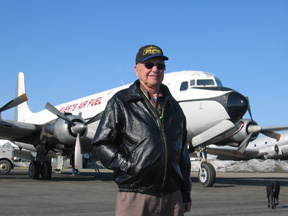#2) Cliff Everts: Pilot and founder of a bush airline service
 Click here to listen to the audio. Story length: 4:11 minutes. File size: 2.89 MB.
Click here to listen to the audio. Story length: 4:11 minutes. File size: 2.89 MB.  Narrator: Welcome to "History at Risk: Linking Alaskans to their Past". In Fairbanks, you can still see twin- and four-engine relics of a by-gone era parked on the Airport Tarmac. If you're lucky, you might catch a glimpse of one lumbering into the air and slowly gaining altitude. Those planes still serve bush villages and remote camps with supplies and fuel. Cliff Everts is the man behind the operation, and his story goes back to the 1940s when aviation was just beginning to touch the lives of rural Alaskans. Everts worked for Wien Airlines hauling supplies for oil exploration on the north slope where he experienced a lifestyle that has changed enormously.
Narrator: Welcome to "History at Risk: Linking Alaskans to their Past". In Fairbanks, you can still see twin- and four-engine relics of a by-gone era parked on the Airport Tarmac. If you're lucky, you might catch a glimpse of one lumbering into the air and slowly gaining altitude. Those planes still serve bush villages and remote camps with supplies and fuel. Cliff Everts is the man behind the operation, and his story goes back to the 1940s when aviation was just beginning to touch the lives of rural Alaskans. Everts worked for Wien Airlines hauling supplies for oil exploration on the north slope where he experienced a lifestyle that has changed enormously.Narrator: Everts was greatly impressed by the gracious hospitality of the Nunamiut Eskimo, and is still in awe of the way Native people skillfully survived the long winters.
Everts: “We slept in sleeping bags and it was pretty cozy with all twelve of us in this caribou hut and in the morning it was 30, 40 below zero outside. Everything was frosted up on the ceiling and the only heat they use was these little kerosene lamps that they used to cook with, and they had willows that they used to burn. They had very little for heat so they had to be pretty well insulated with these caribou hides. I’ll never forget that.”
Narrator: While working for Wien, Everts became a legend for testing aviation technology in harsh polar conditions. He was drawn to the extreme challenge and adventure of aviation in interior Alaska. He thrived in those early days by his own ingenuity and wits.
Everts: “We had plumbers’ fire pots and we had an engine cover. We carried them in the airplane all the time. We would stick this firepot underneath the engine and we would also drain the oil out of the airplane, and we would try to keep it warm. It got cold all right. In the morning, we’d put this warm oil into the engine so it would circulate and we’d have oil pressure right away.”
Narrator: After an eventful career as a pilot, Everts went on to build his own fuel hauling business.
Everts: “A C46 that will haul 14,000 lbs, I felt was a real airplane for what we were doing up here in Alaska. During that time there was so many restrictions as far as operations of flying airplanes for hire. The only way I could see where there was a way to haul some freight was I lashed on to the C46 that Wien’s had. Working for Wien airlines I couldn’t go out and compete with them, so I leased the C46. I had established this 46 operation so retiring from Wien’s, I decided to get into my own business. I bought another C46, then I was able to pick up a DC6 from Pacific Alaska. We started operating it and it just kept on snowballing.”
Narrator: Today, Everts and his daughter run “everts air fuel.” His son expanded the business by forming “Everts air Alaska” and “Everts Air Cargo,” which operate by the help of his sister, mother and many loyal employees. With family pride Everts’companies continue to grow while still relying on vintage aircraft.
Narrator: Funding was provided by the university of Alaska President's Special Projects fund. From the University of Alaska Fairbanks Oral History Department, this is Bill Schneider.